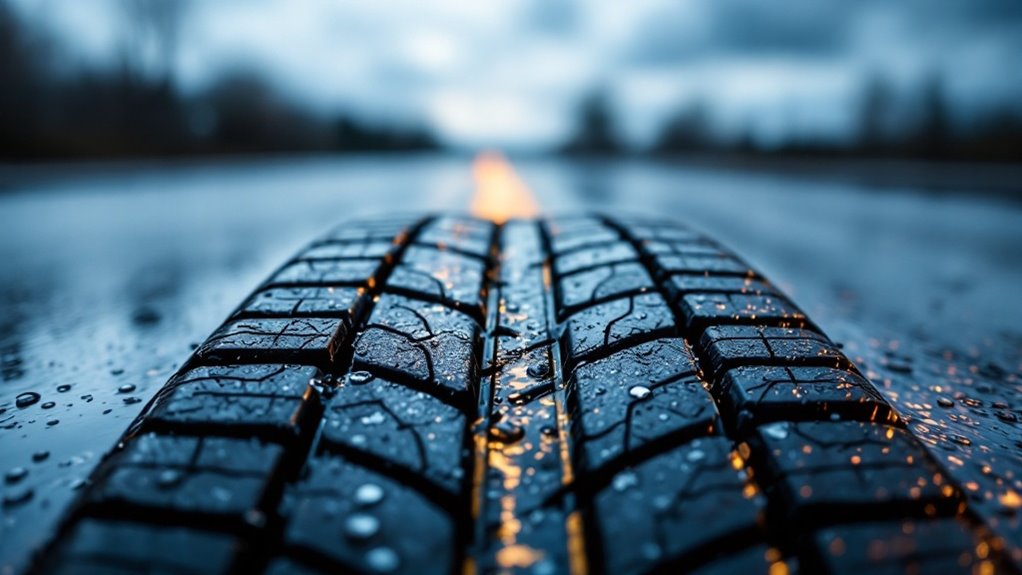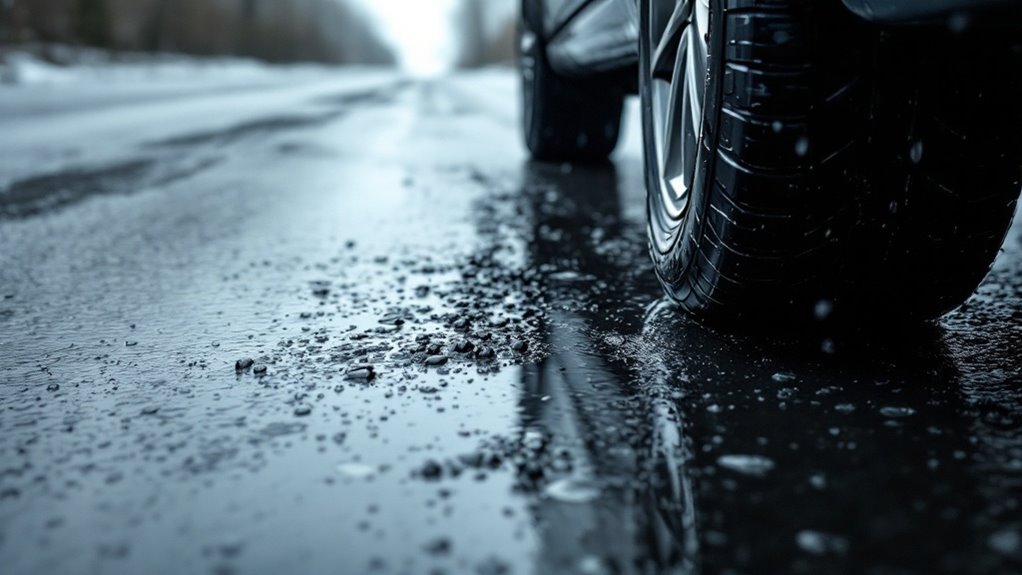Are New Tires Slippery
This post contains affiliate links. As an Amazon Associate, we earn from qualifying purchases.
New tires can feel slippery at first. They have a coating from manufacturing. This layer includes chemical lubricants and release agents. It lowers traction on dry or wet roads. Drive about 300 to 500 miles to wear it off. Gentle driving helps improve grip faster. Tread depth matters a lot for handling. Tire pressure plays a big role too. Road conditions can change how tires feel. Want safer driving with new tires? Stick around for easy tips and tricks.
Essential Facts in 30 Seconds
- New tires can feel slippery due to manufacturing chemicals and lubricants.
- A production release layer reduces initial traction on new tires.
- Antioxidants in the rubber create a slippery surface initially.
- A break-in period of about 500 miles is needed for optimal grip.
- Drivers may need time to adapt to the feel of new tires.
Why Do New Tires Feel Slippery
New tires might feel slippery at first, and that’s normal. This happens because of chemicals used in making them. Factories put lubricants on tires to help during production. These coatings make tires less grippy on the road initially. Winter tires, in contrast, are specifically designed for enhanced traction in cold and snowy conditions, which can be crucial for safe driving.
Also, rubber has antioxidants to stop damage over time. These can add to the slippery feel early on. Additionally, new tires often have a release layer from manufacturing that reduces initial traction until worn off reduces initial traction.
Let’s break down the main reasons for this issue:
- Chemical Layer: Lubricants on the surface fade after a few trips.
- Break-in Time: Tires need about 500 miles to grip well.
- Getting Used To: Drivers must adjust to the new tire feel.
Stick with short drives at first to stay safe. Over time, the slipperiness goes away. Your tires will feel steady and reliable soon. Remember that investing in winter tires can significantly enhance safety in winter weather.
Trust the process, and drive carefully!
Key Factors Affecting Tire Grip

Let’s dive into what makes tires grip the road well. Many things affect how tires stick to different surfaces. Tire material and tread shape are super important. The rubber in tires helps them grab the road. It works best by bending and sticking, even in hot or cold weather. Additionally, tire size can significantly influence traction, especially in varying driving conditions.
Tread shape moves water away on rainy days. This stops tires from sliding on wet roads. Temperature also plays a role, as it can alter tire performance and affect grip levels.
Check these key points to keep your tires gripping strong:
- Tread Depth: Look at it often. Thin tread means less grip and more slipping.
- Tire Pressure: Stick to the car maker’s advice. Right pressure keeps tires touching evenly.
- Road Types: Be careful on wet or icy roads. They make grip much harder.
Understanding Different Tire Types

Tires come in different types for various driving needs and weather. Think about your car and where you drive.
All-season tires work well in dry, wet, or light snow. Summer tires grip best in hot, dry weather with smooth treads. Winter tires have deep grooves for ice and snow. Their rubber stays soft in cold temperatures, which helps maintain enhanced traction on icy and snowy roads.
Your vehicle matters a lot in picking tires. All-terrain tires suit SUVs for rough paths like gravel or mud. They’ve bold treads for strong grip. Choosing the right tire type ensures superior handling and traction.
Ultra-high-performance tires handle speeds over 149 mph. Their unique tread design helps with fast driving.
Match your tire to your roads and car needs. This keeps you safe and driving smooth.
Breaking In Your New Tires

Got new tires on your car? You need a break-in period first. Drive about 300 to 500 miles. That’s around 480 to 800 kilometers. Think of it as one full tank of gas. This helps tires settle in nicely. It removes factory coatings for better safety.
Why does this matter so much? Break-in boosts tire grip over time. It clears slippery stuff from the surface. Your tires handle better on roads. Braking becomes sharper too. Steering feels smooth with steady road touch.
Stick to this simple step for safer rides!
Tips for Safe Driving With New Tires

Got new tires? Awesome! Let’s keep you safe on the road.
First, take it easy for the first 500 miles. Don’t slam on the brakes or speed up fast. This helps the tire coating wear off safely. Drive nice and slow. Brake gently, speed up softly, and turn smoothly. This builds the best grip for your tires.
Next, check tire pressure every month. Use a good gauge for accuracy. Keep the pressure at the right level. This stops uneven wear on tires.
Look at the tread depth often. Rotate tires every 5,000 to 8,000 miles. It helps them last longer. Also, balance and align wheels after putting on new tires. This stops shakes or pulls while driving.
Remember, maintaining the correct tire size is crucial for optimal performance and safety.
Follow these tips for safer rides. Your tires will perform great, even on tough roads!
Frequently Asked Questions
How Long Do New Tires Stay Slippery?
Curious about new tires being slippery? They often stay slick for 100-500 miles. That’s the break-in time. Drive gently during this period. Use smooth braking and slow starts. This helps cut down the slipperiness. Stick to easy driving for best results.
Can Weather Affect New Tire Slipperiness?
Weather plays a sneaky role in how new tires perform. It can change the game fast. Rain makes roads slick, reducing tire grip. Heat can soften rubber, causing slips too. Studies show wet roads raise accident risks by 30%. Hot pavement? It cuts traction even more. Stay sharp and watch the sky. Bad weather means extra caution on new tires.
Do All New Tires Feel Slippery?
Got new tires and they feel slippery? You’re not alone. Many notice this odd slickness at first. Tire tread design plays a big role here. Some grip the road right away. Others need time to settle in. Rubber compounds also affect this slip. Data shows a break-in of 100 miles helps. Drive slow till they feel steady. Stay safe on those fresh wheels!
Is Slipperiness Worse on Certain Surfaces?
Slipperiness changes a lot based on the surface. Wet pavement feels super slick. Traction drops fast on it. You might slip easily there. Gravel roads give better grip. Sliding happens less on them. Data shows wet surfaces cause more falls. Stay careful on rainy days. Which surface feels trickiest to you?
Should I Replace Tires if Slippery?
Are your tires feeling slippery? Check the tread depth right away! Use a penny to test it. If Lincoln’s head shows fully, the tread is too low. That’s below 2/32 inches—time for new tires! Don’t wait and risk your safety. Slippery tires can cause accidents fast. Get to a shop soon. New tires keep you safe on the road. Act now before it’s too late!
Conclusion
New tires can feel slippery at first. They need time to break in. Drive about 200 to 500 miles to make them grip better. Think of a rainy road in Seattle. Speeding on wet roads with new tires is risky. You might slide or lose control. Stay safe by driving slowly. Don’t make quick turns or stops. Try these easy tips to help.
Check tire pressure every week. Keep speeds low on wet roads. Skip sharp turns for now. These steps keep you safe and sound. Trust me, caution pays off big time. Stick to these rules for better grip soon.
